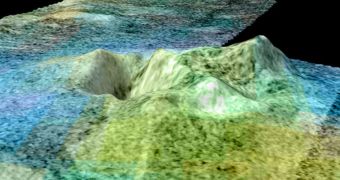Previous analysis of data sent back by the NASA Cassini orbiter determined that the surface of the Saturnine moon Titan was laden with active ice volcanoes. Geologists believed that these landforms helped shape the current landscape on the moon, but a new analysis argues that this was not the case.
Investigators determined that the interior section of the moon was simply too cool to still be active. Without an active core, it is physically impossible to produce ice volcanoes, or any other type of volcano for that matter.
The datasets the new study analyzed contained both topography and surface composition information, all of which were collected by instruments on Cassini. The orbiter has been surveying Saturn, its moons and its ring system since it first achieved orbital insertion, on July 1, 2004.
“When we look at our new 3D map of [a landscape feature called] Sotra Facula on Titan, we are struck by its resemblance to volcanoes like Mt. Etna in Italy,” says the leader of the 3D mapping effort, expert Randolph Kirk.
He is also a Cassini radar team member, and holds an appointment as a geophysicist at the Flagstaff, Arizona based US Geological Survey (USGS) Astrogeology Science Center, Daily Galaxy reports.
The structure aso resembles “Laki in Iceland and even some small volcanic cones and flows near my hometown of Flagstaff,” Kirk goes on to say.
“It would be fantastic to find strong evidence that clearly shows Titan has an internal heat source that causes ice volcanoes and lava flows to form,” adds NASA Ames Research Center planetary scientist Jeff Moore, the lead author of the new study paper .
“But we find that the evidence presented to date is unconvincing, and recent studies of Titan's interior conducted by geophysicists and gravity experts also weaken the possibility of volcanoes there,” adds the expert, who is based in Moffett Field, California.
What the new study demonstrates is that the volcano-like appearance that mountains on the Saturnine moon have may very well be owed to rain. Titan's atmosphere often produces liquid hydrocarbon rains, which pour methane and ethane on the surrounding landscape.
Streams of these two hydrocarbons can erode into the mountains, eventually giving them the distinct look that made planetary scientists think of volcanoes in the first place.
“Titan is a fascinating world. Its uniqueness comes from its atmosphere and organic lakes, but in this study, we find no strong evidence for icy volcanism on Titan,” adds Robert Pappalardo.
The expert holds an appointment as a research scientist at the NASA Jet Propulsion Laboratory (JPL), in Pasadena, California. He is also a former project scientist for the Cassini mission.

 14 DAY TRIAL //
14 DAY TRIAL //